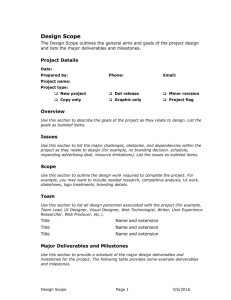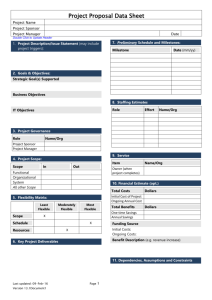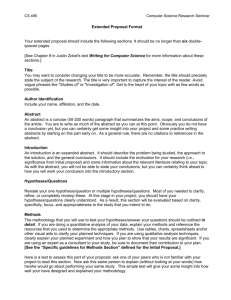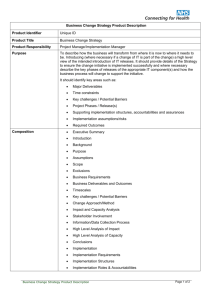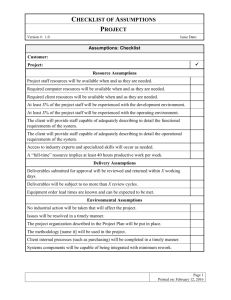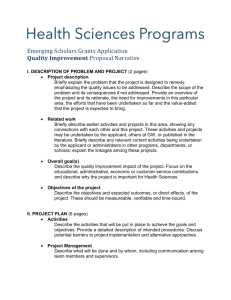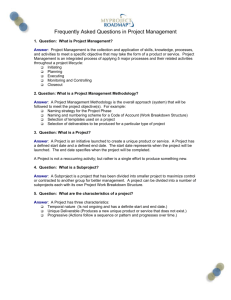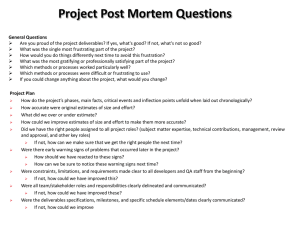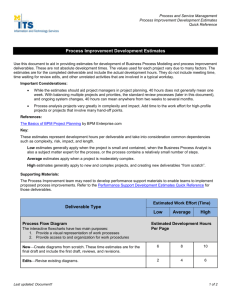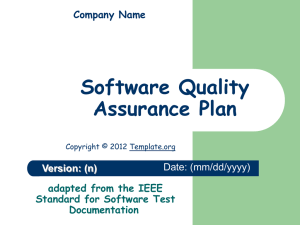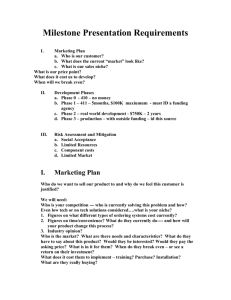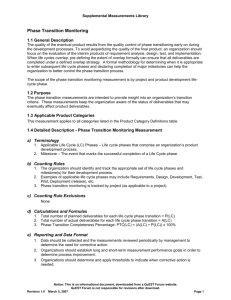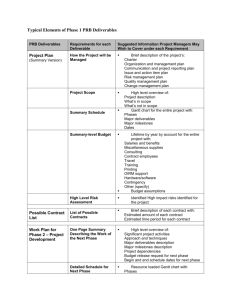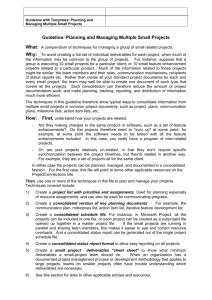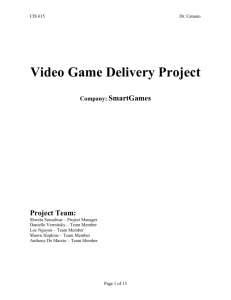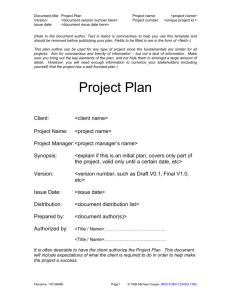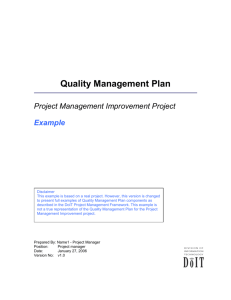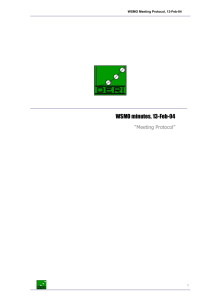Meaning of Project Scope
advertisement
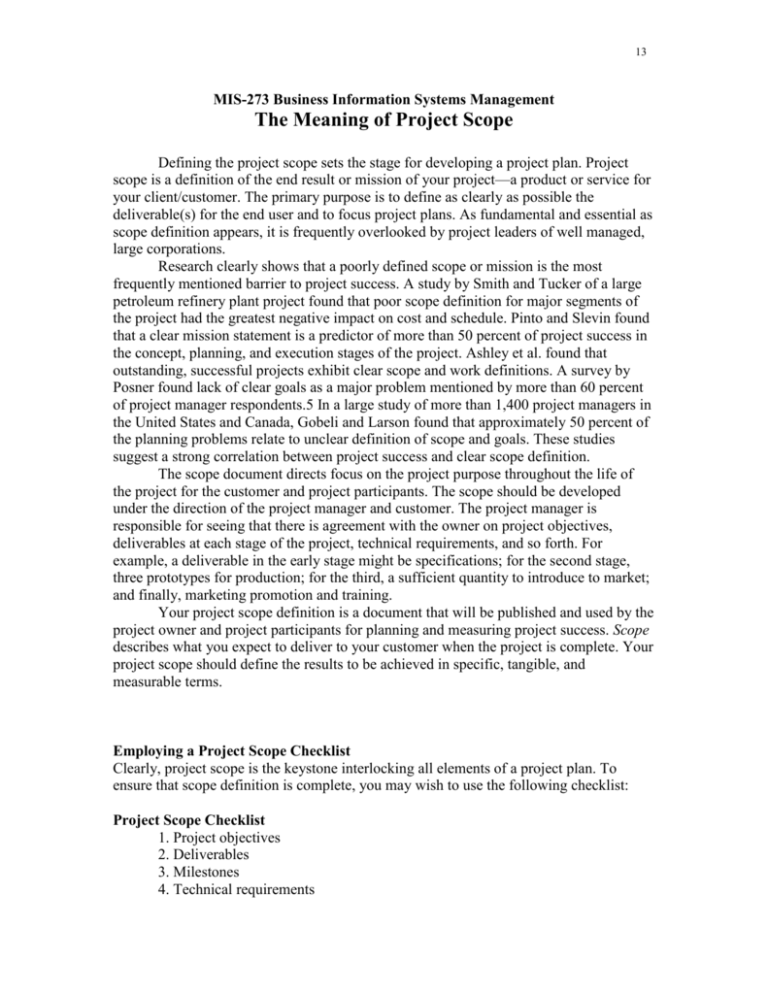
13 MIS-273 Business Information Systems Management The Meaning of Project Scope Defining the project scope sets the stage for developing a project plan. Project scope is a definition of the end result or mission of your project—a product or service for your client/customer. The primary purpose is to define as clearly as possible the deliverable(s) for the end user and to focus project plans. As fundamental and essential as scope definition appears, it is frequently overlooked by project leaders of well managed, large corporations. Research clearly shows that a poorly defined scope or mission is the most frequently mentioned barrier to project success. A study by Smith and Tucker of a large petroleum refinery plant project found that poor scope definition for major segments of the project had the greatest negative impact on cost and schedule. Pinto and Slevin found that a clear mission statement is a predictor of more than 50 percent of project success in the concept, planning, and execution stages of the project. Ashley et al. found that outstanding, successful projects exhibit clear scope and work definitions. A survey by Posner found lack of clear goals as a major problem mentioned by more than 60 percent of project manager respondents.5 In a large study of more than 1,400 project managers in the United States and Canada, Gobeli and Larson found that approximately 50 percent of the planning problems relate to unclear definition of scope and goals. These studies suggest a strong correlation between project success and clear scope definition. The scope document directs focus on the project purpose throughout the life of the project for the customer and project participants. The scope should be developed under the direction of the project manager and customer. The project manager is responsible for seeing that there is agreement with the owner on project objectives, deliverables at each stage of the project, technical requirements, and so forth. For example, a deliverable in the early stage might be specifications; for the second stage, three prototypes for production; for the third, a sufficient quantity to introduce to market; and finally, marketing promotion and training. Your project scope definition is a document that will be published and used by the project owner and project participants for planning and measuring project success. Scope describes what you expect to deliver to your customer when the project is complete. Your project scope should define the results to be achieved in specific, tangible, and measurable terms. Employing a Project Scope Checklist Clearly, project scope is the keystone interlocking all elements of a project plan. To ensure that scope definition is complete, you may wish to use the following checklist: Project Scope Checklist 1. Project objectives 2. Deliverables 3. Milestones 4. Technical requirements 23 5. Limits and exclusions 6. Reviews with customer 1. Project objectives. The first step of project scope definition is to define the major objectives to meet your customer’s need(s). For example, as a result of extensive market research a computer software company decides to develop a program that automatically translates verbal sentences in English to Russian. The project should be completed within three years at a cost not to exceed $1.5 million. Another example is to design and produce a completely portable, hazardous waste, thermal treatment system in 13 months at a cost not to exceed $13 million. Project objectives answer the questions of what, when, and how much. 2. Deliverables. The next step is to define major deliverables—the expected outputs over the life of the project. For example, deliverables in the early design phase of a project might be a list of specifications. In the second phase deliverables could be software coding and a technical manual. The next phase could be to test prototypes. The final phase could be final tests and approved software. Deliverables typically include time, quantity, and/or cost estimates. 3. Milestones. A milestone is a significant event in a project that occurs at a point in time. The milestone schedule shows only major segments of work; it represents first, rough cut estimates of time, cost, and resources for the project. The milestone schedule is built using the deliverables as a platform to identify major segments of work and an end date—for example, testing complete and finished by July 1 of the same year. Milestones should be natural, important control points in the project. Milestones should be easy for all project participants to recognize. 4. Technical requirements. More frequently than not, a product or service will have technical requirements to ensure proper performance. For example, a technical requirement for a personal computer might be the ability to accept 120-volt alternating current or 240-volt direct current without any adapters or user switches. Another wellknown example is the ability of 911 emergency systems to identify the caller’s phone number and location of the phone. Examples from IS projects include speed and capacity of database systems and connectivity with alternative systems. For an unusual set of requirements, see the Operation Keiko Lift snapshot. 5. Limits and exclusions. The limits of scope should be defined. Failure to do so can lead to false expectations and to expending resources and time on the wrong problem. Examples of limits are local air transportation to and from base camps will be outsourced; system maintenance and repair will be done only up to one month after final inspection; client will be billed for additional training beyond that prescribed in the contract. Exclusions further define the boundary of the project by stating what is not included. Examples include: data will be collected by the client, not the contractor; a house will be built, but no landscaping or security devices added; software will be installed, but no training given. 33 6. Reviews with customer. Completion of the scope checklist ends with a review with your customer—internal or external. The main concern here is the understanding and agreement of expectations. Is the customer getting what he or she desires in deliverables? Does the project definition identify key accomplishments, budgets, timing, and performance requirements? Are questions of limits and exclusions covered? Clear communication in all these issues is imperative to avoid claims or misunderstanding. In summary, close liaison with your customer is necessary to develop a project definition that meets all the requirements of the customer. Clear scope definition ensures you will know when a change in scope occurs. A clear project scope definition is the primary prerequisite for development of your work breakdown structure. Scope definition provides an administrative plan that is used to develop your operational plan. Scope definition should be as brief as possible but complete; one or two pages are typical for small projects. (excerpted from Gray−Larson: Project Management: The Managerial Process, Chapter 2. Copyright 2003 by McGraw-Hill)
